肺动脉高压 CTPA
肺动脉高压

肺动脉高压肺动脉高压是由于心脏、肺及肺血管疾病导致的肺动脉压力增高。
可分为原发性肺动脉高压及继发性肺动脉高压。
继发性肺动脉高压远较原发性肺动脉高压为多见。
(1)原发性肺动脉高压是无法解释或原因不明的肺动脉高压。
(2)继发性肺动脉高压是因心脏、血管及呼吸系统疾病导致的肺动脉高压。
肺动脉栓塞:来自体循环静脉及右心腔的各种栓子机械性阻塞肺动脉系统而引发的一组疾病,形成肺动脉高压,主要包括肺动脉血栓栓塞等。
正常肺动脉压力(静息时)(1)收缩压:18~25 mmHg;(2)舒张压:6~10 mmHg;(3)平均压:12~16 mmHg。
肺动脉高压(1)静息时收缩压:>30 mmHg;(2)静息时平均压:>20 mmHg;(3)运动时平均压:>30 mmHg。
【病理解剖】各种导致肺动脉高压的疾病引起的病理改变不同,但均有肺血管中层肥厚、内皮细胞增生、管腔狭窄等病理变化,肺血管张力明显增高和总横截面积明显减少。
原发性肺动脉高压是因动脉中层肥厚、向心或偏心性内膜增生及丛状损害和坏死性动脉炎等构成。
肺动脉血栓栓塞的栓子可来自上、下腔静脉系统或右心,多源于下肢深静脉;肺动脉血栓栓塞可发生于单一或多部位,并可在局部进一步继发血栓形成;栓塞的动脉及其分支达到一定程度后,通过机械阻塞作用和神经体液、低氧血症引起的肺动脉收缩,导致肺循环阻力增高、肺动脉高压。
【血流动力学改变】长期肺动脉高压(后负荷增加)使右室壁张力增高、室壁肥厚。
肺动脉高压超过右心代偿能力后,右心排出量下降,右室收缩末期残留血量增加、舒张末压增高,右心扩大,直至右心衰竭。
急性肺动脉高压右室来不及代偿增厚、右室搏出量明显减少、右室舒张末期容量增加,心腔明显扩大,最终收缩功能衰竭。
右室收缩压升高导致右室射血时间延长,致收缩晚期和舒张早期右室压力超过左室压力;同时右心扩大致室间隔左移,左心舒张受限,左心排出量降低。
体循环回心血量减少,体循环静脉淤血。
最新:中国肺动脉高压诊治临床路径

最新:申国肺动脉高压诊治临床路径肺动脉高压(pulmona叩hypertension, PH )是以肺动脉压力升高为特征的一种异常的血液动力学状态和病理生理综合征1-2],真致死率、致残率高。
当前数据表明,全球约1%的成年人患高PH,65岁以上的人群中PH患病率可高达10%[坷,PH已成为严重威胁人类的全球性健康问题。
《2022年中国心血管病医疗质量报告》显示,我国PH的知晓率、诊断率和治疗率均不理想,特别是在基层医疗机构中,医疗技术力量不足、综合管理意识薄弱、转诊机制不完善等问题普遍存在,PH规范化诊疗水平亟待提高。
为了全面提升各级医疗机构的诊疗能力,有序开展PH的阜期筛查与诊治、患者随访管理以及健康教育等工作,适应PH患者日益增长的医疗需求,国家心血管病中心肺动脉高压专科联盟、国家心血筐病专家委员会右心与肺血筐病专业委员会组织多学科专家对PH领域的指南、专家共识以及重要循证医学研究进行了系统检索[4-6],并组织多轮调研,最终选选和确定了基层PH诊疗和筐理相关的关键临床问题,经审核和讨论制定了《中国肺动脉高压诊治临床路径》。
本文主要内窑涵盖了PH的诊断流程、治疗策略、随in筐理和双向转诊机制等,强调规范性、可操作性和可及性,将循i正医学证据与基层实践特点相结合,总结了国内外多学科协同诊疗的先进经验,对中目关学科如心血筐、呼吸、风湿免疫、肝病等领域的日常诊疗实践均真高较强的指导意义。
1、PH的定义a台类1.1 PH的血液动力学定义PH是指多种原因所致肺血管床结构和(或)功能改变,导致肺动脉压力增高,右心扩张,出现右心衰竭甚至死亡的一组临床综合征。
真血液动力学定义?旨:在海平面、静息状态下,经右,I)号筐检查( righthea内catheterization, RHC )测定的平均肺动脉压( meanpulmonaryarterypressure, mPAP) >20mmHg( 1mmHg=0.133kPa)。
ct肺动脉高压诊断标准
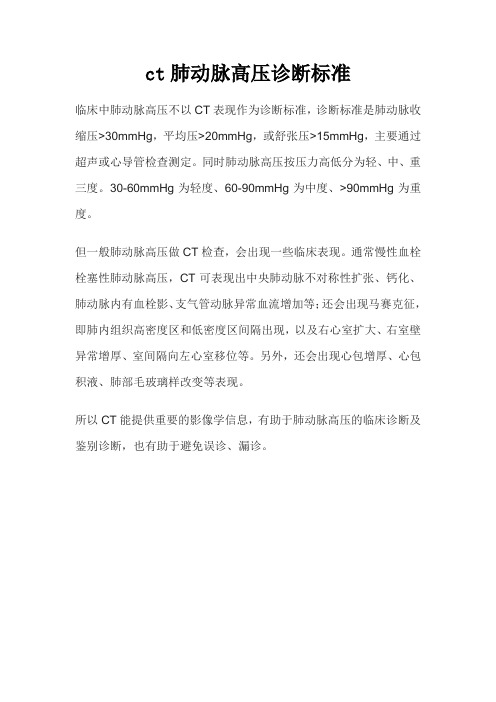
ct肺动脉高压诊断标准
临床中肺动脉高压不以CT表现作为诊断标准,诊断标准是肺动脉收缩压>30mmHg,平均压>20mmHg,或舒张压>15mmHg,主要通过超声或心导管检查测定。
同时肺动脉高压按压力高低分为轻、中、重三度。
30-60mmHg为轻度、60-90mmHg为中度、>90mmHg为重度。
但一般肺动脉高压做CT检查,会出现一些临床表现。
通常慢性血栓栓塞性肺动脉高压,CT可表现出中央肺动脉不对称性扩张、钙化、肺动脉内有血栓影、支气管动脉异常血流增加等;还会出现马赛克征,即肺内组织高密度区和低密度区间隔出现,以及右心室扩大、右室壁异常增厚、室间隔向左心室移位等。
另外,还会出现心包增厚、心包积液、肺部毛玻璃样改变等表现。
所以CT能提供重要的影像学信息,有助于肺动脉高压的临床诊断及鉴别诊断,也有助于避免误诊、漏诊。
肺动脉高压

肺动脉高压的临床分类
临床上将 PH分为 5大类
分类
亚类
1.动脉性肺动脉高压(PAH) 1.1特发性肺动脉高压(IPAH)
1.2遗传性肺动脉高压(HPAH)
1.3药物和毒物相关肺动脉高压
1.4疾病相关的肺动脉高压
1.4.1 结缔组织病
1.4.2 HIV感染
1.4.3 门脉高压
1.4.4 先天性心脏病
4. 可溶性鸟苷酸环化酶(soluable guanylate cyclase,sGC)激动剂
5.前列环素类似物和前列环素受体激动剂
PAH的治疗
(四)靶向药物联合治疗和药物间相互作用
1.靶向药物联合治疗 2.药物相互作用:靶向药物联合治疗时需考虑到药物间的相互作用。
谢谢
5.2 系统性和代谢性疾病(如结节病、戈谢氏病、糖原储积症)
5.3复杂性先天性心脏病
5.4 其他(如纤维性纵隔炎)
临床表现
主要表现为进行 性右心功能不全的相关症状,常为劳累后诱发,表现为疲劳、呼 吸困难、胸闷、胸痛和晕厥,部分患者还可表现为干咳和运动诱发的恶心、呕吐。 晚期患 者静息状态下可有症状发作。 随着右心功能不全 的加重可出现踝部、下肢甚至腹部、全身水肿。
可直接评价右心室大小、 形态和功能,并可无创 评估血流量,包括心输 出量、每搏输出量和右 心室质量。
血液学检查
血液学检查主要用于 筛查PH的病因和评价 器官损害情况
PAH的治疗
(一)一般措施
1.体力活动和专业指导下的康复:PAH患者应在药物治疗的基础上、在专业指导下进行运动康复训练 2. 妊娠、避孕及绝经后激素治疗:随着靶向药物的广泛应用,妊娠 PAH患者死亡率有所下降,但仍在 5%~23%,且妊娠并发症多,因此,建议PAH患者避免怀孕。 3.择期手术:对PAH患者即使进行择期手术也会增加患者风险,接受择期手术者,硬膜外麻醉可能比全 身麻醉耐受性好。 4. 预防感染:PAH 患者容易合并肺部感染,而 肺部感染是加重心衰甚至导致死亡的重要原因之 一。 5.社会心理支持
中国肺动脉高压诊治临床路径(2023)

▪ 通过完善心电图、X线胸片、超声心动图、心脏C血管造影、心血管介入、心脏磁共振 成像等检查,有助于明确左心疾病所致肺动脉高压的诊断,必要时行右心导管检查, 肺动脉楔压(PAWP)>15 mmHg考虑左心疾病所致肺动脉高压。
3、超声心动图评估肺动脉高压患者的预后:右心室功能不全是肺动脉高压 患者预后的重要指标。超声心动图评估右心功能指标包括收缩期三尖瓣环 位移距离(TAPSE)、右心室面积变化分数、组织多普勒测定的右心室游离 壁应变和三尖瓣环速率、三维超声心动图测定的右心室射血分数,以及 TAPSE/肺动脉收缩压比值等。
肺动脉高压确诊
2、急性血管反应性试验 ▪ 对于特发性动脉型肺动脉高压(IPAH)、可遗传性动脉型肺动脉高压、药
物和毒物相关动脉型肺动脉高压患者首次进行右心导管检查时,应行急性 血管反应性试验,以筛选出对钙拮抗剂治疗有效的动脉型肺动脉高压患者。 ▪ 急性血管反应性试验药物及用法见表5,当用药剂量达到目标剂量或出现 低血压、严重心动过缓、头晕、胸闷、四肢麻木等不良反应时应终止试验, 复测肺动脉压力、心排量等血液动力学参数。
肺动脉高压患者的转诊
2、疑诊肺动脉高压患者的具体转诊流程如图4所示。
谢谢观看
肺动脉高压确诊
▪ 急性血管反应性试验阳性的标准:平均肺动脉压下降至少10 mmHg, 且绝对值降至40 mmHg以下,心排出量升高或维持不变。
明确肺动脉高压的病因
1、筛查左心疾病 ▪ 左心疾病所致肺动脉高压是最常见的肺动脉高压类型,可由射血分数降低、射血分数
轻度降低和射血分数保留的心力衰竭,以及左心瓣膜性心脏病引起。另外,先天性或 获得性肺静脉狭窄也可以引起肺动脉高压。
肺动脉CT血管造影技术(CTPA)课件

肺动脉CT血管造影(CTPA)
因内源性或外源性栓子阻塞肺动脉或其主要分支引起肺循环障 碍的病理生理综合征。据国内外尸检报告,约有67%~79%PE 病人生前未能得到正确诊断。而国内的漏诊率高达80%以上; 未经治疗者,死亡率可高达20%-30%,及时诊治者,死亡率 可降至8%。目前,核素肺显像仍为PE常规检查,但是特异性 低,主要用于筛查病人。随着医学影像学设备的更新,CT和 MRI等微创检查方法,已逐步成为诊断PE的首选,CTPA诊断PE 的敏感性可达75%-100%,特异性可达80%-100%,对于叶 、段动脉显示的准确性更高,有助于明确肺动脉内栓子的位 置、范围、程度、性质和肺动脉血流动力学状态等。
肺循环的生理特点
肺动脉及其分支都较粗,管壁较主动脉及其分支薄。肺循 环的全部血管都在胸腔内,而胸腔内的压力低于大气压。 这些因素使肺循环有与体循环不同的一些特点。
肺动脉血流阻力和血压肺动脉管壁厚度仅为主动脉的三分 之一,其分支短而管径较粗,故肺动脉的可扩张性较高, 对血流的阻力较小。
肺循环的生理特点
碘积图--肺
CTPA图像对栓子的检出率与图像后处理方法也密切相。 CTA是将螺旋CT扫描与计算机三维图像重建两种技术 结合来显示血管结构的技术,而三维重建是图像后处理技 术的一大飞跃。
MPR CPR
MPR或CPR是一种简便的二维成像方法,它是将一组 横断面图像的数据进行重新排列,能有效地进行任意断 面的二维图像重建,与CTA的原始数据保持一致,所 以是最准确的显示方法,其中肺栓子的检出率也以MP R最好。
CT血管造影的影响因素 1.患者的自身因素 2.扫描方面的因素
3.对比剂注射方面的因素
1.患者的自身因素
肺动脉高压
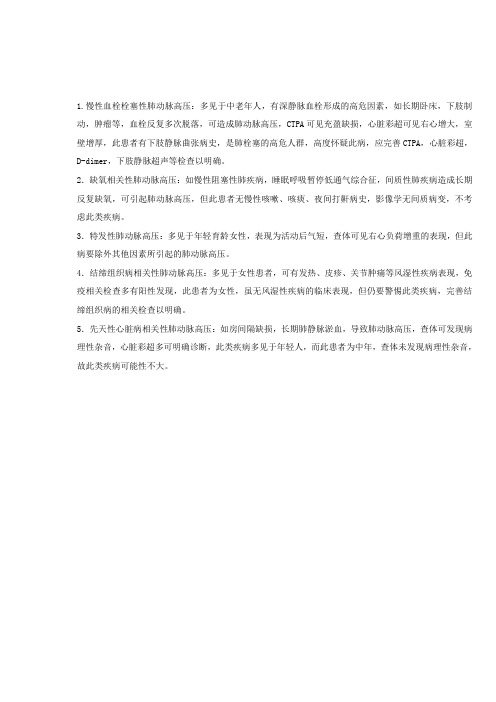
1.慢性血栓栓塞性肺动脉高压:多见于中老年人,有深静脉血栓形成的高危因素,如长期卧床,下肢制动,肿瘤等,血栓反复多次脱落,可造成肺动脉高压,CTPA可见充盈缺损,心脏彩超可见右心增大,室壁增厚,此患者有下肢静脉曲张病史,是肺栓塞的高危人群,高度怀疑此病,应完善CTPA,心脏彩超,D-dimer,下肢静脉超声等检查以明确。
2.缺氧相关性肺动脉高压:如慢性阻塞性肺疾病,睡眠呼吸暂停低通气综合征,间质性肺疾病造成长期反复缺氧,可引起肺动脉高压,但此患者无慢性咳嗽、咳痰、夜间打鼾病史,影像学无间质病变,不考虑此类疾病。
3.特发性肺动脉高压:多见于年轻育龄女性,表现为活动后气短,查体可见右心负荷增重的表现,但此病要除外其他因素所引起的肺动脉高压。
4.结缔组织病相关性肺动脉高压:多见于女性患者,可有发热、皮疹、关节肿痛等风湿性疾病表现,免疫相关检查多有阳性发现,此患者为女性,虽无风湿性疾病的临床表现,但仍要警惕此类疾病,完善结缔组织病的相关检查以明确。
5.先天性心脏病相关性肺动脉高压:如房间隔缺损,长期肺静脉淤血,导致肺动脉高压,查体可发现病理性杂音,心脏彩超多可明确诊断,此类疾病多见于年轻人,而此患者为中年,查体未发现病理性杂音,故此类疾病可能性不大。
肺栓塞CTPA间接征象诊断价值分析及临床意义

肺栓塞CTPA间接征象诊断价值分析及临床意义肺栓塞是一种严重的疾病,临床上常用CT肺动脉造影(CTPA)来确诊。
CTPA是一种非侵入性的检查方法,通过静脉注射造影剂,可以清晰地显示肺动脉及其分支,从而检测肺栓塞的存在。
除了直接显示肺栓塞栓子的存在,CTPA还可以显示一些间接征象,这些间接征象对于肺栓塞的诊断和评估有着重要的意义。
肺栓塞CTPA间接征象包括以下几个方面:1. 急性肺动脉高压:肺栓塞后,肺动脉血流受阻,引起肺动脉压力升高。
CTPA可以显示肺动脉的扩张和肺动脉高压征象,如右室增大、右室壁增厚和主动脉弓增宽等。
2. 肺血管影缺损:肺栓塞时,栓子堵塞了肺动脉,导致肺动脉分支的血管影消失。
CTPA可以显示这些肺血管影缺损,并可以根据缺损的程度和范围来评估肺栓塞的严重程度。
3. 肺梗死:肺栓塞时,部分肺动脉分支的供血受到影响,导致局部肺组织缺血和坏死,形成肺梗死。
CTPA可以显示这些肺梗死灶,表现为肺实变或肺不张区域。
4. 间断征象:肺栓塞后,肺动脉血流堵塞和动脉间断导致肺动脉分支的血流变得不连续,出现间断征象。
CTPA可以显示这些间断征象,提示肺栓塞的存在。
肺栓塞CTPA间接征象的诊断价值主要体现在以下几个方面:1. 提供了肺栓塞的间接证据:除了直接显示栓子的存在以外,CTPA间接征象可以提供肺栓塞的其他证据,有助于确立肺栓塞的诊断。
2. 评估肺栓塞的严重程度:CTPA间接征象可以评估肺栓塞的严重程度,如肺动脉高压、肺血管影缺损程度等,从而帮助医生选择合适的治疗方案。
3. 指导治疗和预后评估:CTPA间接征象可以指导治疗,例如对于肺梗死区域的处理和选择抗凝治疗的时机。
CTPA间接征象还可以评估肺栓塞的后果和预后,例如肺动脉高压的严重程度与预后的关系等。
肺栓塞CTPA间接征象具有重要的诊断价值和临床意义。
通过观察和分析这些间接征象,可以更准确地诊断和评估肺栓塞的严重程度,并指导后续的治疗和预后评估。
肺血管疾病的影像学诊断

肺血管疾病的影像学诊断摘要:肺血管疾病是一类涉及肺循环的疾病,包括肺动脉高压、肺栓塞、肺血管炎等。
影像学检查是诊断肺血管疾病的关键手段,主要包括胸部X光片、CT肺动脉造影、磁共振成像等。
本文将对肺血管疾病的影像学诊断进行综述,以期为临床诊断提供参考。
一、引言肺血管疾病是指影响肺循环的疾病,其病因多种多样,包括遗传因素、炎症、肿瘤、感染等。
肺血管疾病的临床表现缺乏特异性,早期诊断困难,容易误诊和漏诊。
影像学检查在肺血管疾病的诊断中具有重要价值,可以直观地显示肺血管的病变情况,为临床诊断和治疗提供重要依据。
二、影像学检查方法1.胸部X光片:胸部X光片是筛查肺血管疾病的首选方法,可以初步观察肺血管的形态、分布和大小。
但对于肺血管疾病的确诊价值有限。
2.CT肺动脉造影(CTPA):CTPA是诊断肺血管疾病的重要手段,具有较高的空间分辨率和时间分辨率。
通过注射对比剂,可以清晰地显示肺动脉及其分支的充盈情况,对肺栓塞、肺动脉高压等疾病具有较高的诊断价值。
3.磁共振成像(MRI):MRI具有无辐射、多参数成像的优势,可以全面评估肺血管的病变。
MRI肺动脉造影(MRPA)可以显示肺动脉及其分支的充盈情况,对肺栓塞、肺动脉高压等疾病具有一定的诊断价值。
4.超声心动图:超声心动图可以评估右心功能,间接反映肺动脉高压的严重程度。
同时,超声心动图可以观察肺动脉血流速度,对肺栓塞等疾病具有一定的诊断价值。
5.放射性核素肺通气/灌注显像:放射性核素肺通气/灌注显像是评估肺血流分布的一种方法,对肺栓塞具有较高的诊断价值。
但该方法存在放射性损伤,不适用于孕妇和儿童。
三、影像学诊断要点1.肺动脉高压:CTPA和MRPA可以清晰地显示肺动脉及其分支的扩张、扭曲等改变,同时可以评估肺动脉压力。
超声心动图可以观察右心功能,间接反映肺动脉高压的严重程度。
2.肺栓塞:CTPA是诊断肺栓塞的首选方法,可以明确栓塞部位、范围和程度。
放射性核素肺通气/灌注显像可以评估肺血流分布,对肺栓塞具有较高的诊断价值。
肺动脉高压的ct诊断标准
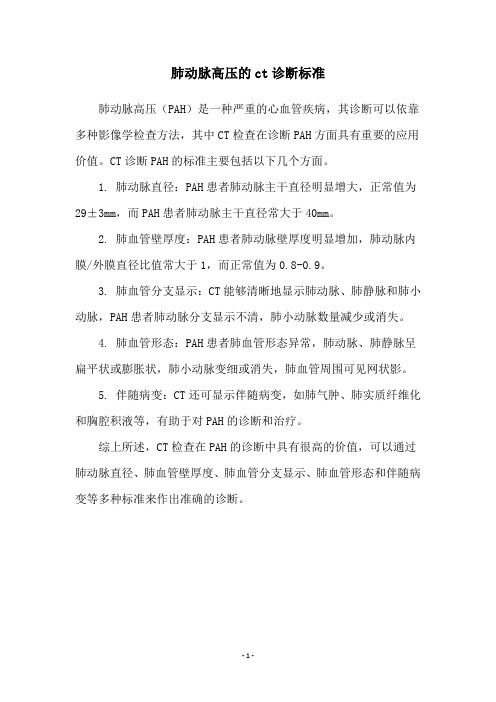
肺动脉高压的ct诊断标准
肺动脉高压(PAH)是一种严重的心血管疾病,其诊断可以依靠多种影像学检查方法,其中CT检查在诊断PAH方面具有重要的应用价值。
CT诊断PAH的标准主要包括以下几个方面。
1. 肺动脉直径:PAH患者肺动脉主干直径明显增大,正常值为29±3mm,而PAH患者肺动脉主干直径常大于40mm。
2. 肺血管壁厚度:PAH患者肺动脉壁厚度明显增加,肺动脉内膜/外膜直径比值常大于1,而正常值为0.8-0.9。
3. 肺血管分支显示:CT能够清晰地显示肺动脉、肺静脉和肺小动脉,PAH患者肺动脉分支显示不清,肺小动脉数量减少或消失。
4. 肺血管形态:PAH患者肺血管形态异常,肺动脉、肺静脉呈扁平状或膨胀状,肺小动脉变细或消失,肺血管周围可见网状影。
5. 伴随病变:CT还可显示伴随病变,如肺气肿、肺实质纤维化和胸腔积液等,有助于对PAH的诊断和治疗。
综上所述,CT检查在PAH的诊断中具有很高的价值,可以通过肺动脉直径、肺血管壁厚度、肺血管分支显示、肺血管形态和伴随病变等多种标准来作出准确的诊断。
- 1 -。
肺动脉高压PPT演示课件

心脏再同步治疗
对于部分严重心力衰竭患者,可 考虑心脏再同步治疗,改善心脏
功能。
肺部感染的预防和处理
疫苗接种
接种流感疫苗、肺炎球菌疫苗等,降低肺部感染 风险。
避免感染源
避免接触呼吸道感染患者,注意个人卫生和室内 通风。
抗感染治疗
一旦发生肺部感染,应及时使用抗生素等药物进 行抗感染治疗。
血栓栓塞的预防和处理
常规心电图检查
心电图表现
肺动脉高压患者心电图常表现为右心室肥大、右心房扩大等 。
辅助诊断
心电图检查可辅助诊断肺动脉高压,但需要结合其他检查方 法综合判断。
超声心动图检查
超声心动图表现
肺动脉高压患者超声心动图常表现为右心室壁增厚、右心室扩大、肺动脉增宽等 。
评估病情
超声心动图检查可评估肺动脉高压患者的病情严重程度,包括肺动脉压力、心脏 功能等。
03
04
环境舒适
保持室内空气流通,温度适宜 ,避免患者接触烟雾、粉尘等
刺激性物质。
饮食调整
根据患者病情和饮食习惯,调 整饮食结构,保证营养均衡。
按时服药
遵医嘱按时服药,不可随意更 改药物剂量或停药。
预防感染
注意个人卫生,避免去人群密 集的场所,防止感染。
定期随访和评估调整治疗方案
定期随访
按照医生建议定期进行随访检查,包括心电图、超声心动 图等。
病情评估
医生会根据患者的症状、体征和检查结果对病情进行评估 。
治疗方案调整
根据病情评估结果,医生可能会调整治疗方案,包括药物 种类和剂量的调整。
注意事项
在随访期间,患者应向医生详细汇报自己的症状变化和用 药情况,以便医生更好地了解病情并制定合适的治疗方案 。
肺动脉高压分类与诊断标准
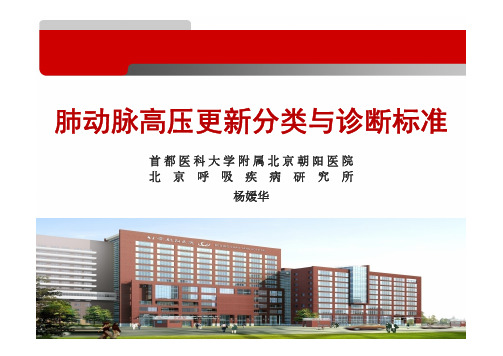
肺动脉高压更新分类与诊断标准首都医科大学附属北京朝阳医院北京呼吸疾病研究所杨媛华肺动脉高压的诊断标准Mean PAP ≥ 25 mmHgPAWP ≤ 15 mmHgPVR > 3 Wood unitsPAP: pulmonary arterial pressure; PAWP: pulmonary artery wedge pressure; PVR: pulmonary vascular resistanceDefinition of PHDefinition of PAHMean PAP ≥ 25 mmHgHoeper MM, et al. J Am Coll Cardiol 2013; 62:D42-50.诊断标准血流动力学诊断标准在海平面、静息状态下,平均肺动脉压(mPAP)≥25mmHg右心导管检查为测定肺动脉压力的参比指标(“金标准”),是临床诊断肺动脉高压的确诊依据绝大多数多普勒超声心动图估测三尖瓣峰流速>3.4m/s 或肺动脉收缩压>50 mmHg的患者最终可确诊为PH基本概念•肺动脉高压(pulmonary hypertension, PH)是由已知或未知原因引起肺动脉内压力异常升高的疾病或病理生理综合征,存在肺循环障碍与右心高负荷,可导致右心衰竭甚至死亡。
肺动脉高压在临床常见,是严重危害人民健康的医疗保健问题。
动脉性肺动脉高压动脉性肺动脉高压(PAH)是指病变直接累及肺动脉并引起肺动脉结构和功能异常的肺动脉高压血流动力学诊断标准:mPAP≥25mmHg,PAWP≤15 mmHg,PVR>3WU特发性肺动脉高压(IPAH)是指原因不明的PAH,过去被称为原发性肺动脉高压(PPH)肺动脉高压分类的变迁原发性PHPAH左心疾病相关PH 肺动脉高压继发性PH 肺部疾病相关PH CTEPH其他未明机制1998年以前1998年以后肺动脉高压临床分类低氧或肺部慢性血栓动脉性肺动左心疾病其他未明肺动脉高压疾病相关PH栓塞性PH脉高压(PAH)相关性PH机制PH特发性PAH 遗传性 疾病相关性CTDHIV门脉高压 先心病 血吸虫1’PVOD or PCH 1’’新生儿收缩功能不全 舒张功能不全 瓣膜疾病 先天性/获得性左室流入/流出道梗阻慢阻肺 间质性肺病睡眠呼吸障碍肺泡低通气 长期居住高原环境发育性肺部疾病血液系统疾病骨髓增生异常 脾切除… … 系统性疾病结节病 平滑肌瘤病 … …代谢性疾病 其他肺动脉高压的新分类(2013年,尼斯)•动脉性肺动脉高压1.1 特发性肺动脉高压1.2 遗传性肺动脉高压1.2.1BMPR21.2.2ALK1,ENG,SMAD9,CAV1,1’肺静脉闭塞病、肺毛细血管瘤样增生症KCNK31.2.3unknown1.3 药物或毒素相关性肺动脉高压1.4 疾病相关性肺动脉高压1.4.1结缔组织疾病1.4.2HIV感染1.4.3门脉高压1.4.4先天性心脏病1.4.5血吸虫病1〞新生儿持续性肺动脉高压药物或毒素所致肺动脉高压的更新肯定相关(definite)可能相关(possible)阿米雷司可卡因芬氟拉明苯丙醇胺右芬氟拉明St. John’s wort有毒性的菜籽油化疗药物苯氟雷司干扰素a和b血清素再摄取抑制剂(SSRIs)苯丙胺类似药物很可能相关(likely)不可能相关(unlikely)苯丙胺类雌激素L-色氨酸口服避孕药甲基苯丙胺吸烟达沙替尼2015 ESC/ERS更新明确很可能有可能阿米雷司芬氟拉明右芬氟拉明安非他明达沙替尼左旋色氨酸可卡因苯丙醇胺圣约翰草毒菜籽油苯氟雷司选择性5-羟色胺再摄取抑制剂a 脱氧麻黄碱安非他明类似物干扰素α、β部分化疗药物如烷化剂(丝裂霉素C、环磷酰胺)ba母亲服药可增加新生儿患持续性肺动脉高压的风险b烷化剂可能是肺静脉闭塞性疾病的原因导致PAH的药物总结•过去5年,一些新的药物被证明可能导致PAH –苯氟雷司-PAH:2009年第1例报道–达沙替尼-PAH:2012年9例,法国注册登记研究–IFN-PAH:2013年,法国注册登记研究•启示–对PAH患者,需要仔细询问服用药物史–国内或国际注册登记研究有明显的优势–应强调向药物管理部门报告所用药物的副作用2015 ESC/ERS分类2015PVOD与PCH1’.肺静脉闭塞病与肺毛细血管瘤样增生症与PAH不同–显著的肺间质改变:听诊可有爆裂音,CT显示磨玻璃改变、小叶间隔增厚,DLCO降低;–治疗反应不同:对常用的肺动脉高压治疗药物无效,反而加重肺水肿;抗凝剂慎用与PAH无法截然分开–肺小动脉病理改变相似:内膜纤维化、中层肥厚等–临床特点相似:常难以鉴别,PVOD/PCH常被误诊为IPAH——Simonneau G, et al. J Am Coll Cardiol. 2009;54:s43-54PAH-CHD分类的更新PAH-CHD发病机制与疾病进程•扩张肺血管的物质减少(一氧化氮,前列环素)•缩血管物质增多(内皮素-1,血栓素A2)•肺血管平滑肌肥厚•肺血管丛状改变•内膜纤维化、血管闭塞肺动脉高压的新分类(2013年,尼斯)•左心疾病相关性 收缩功能不全舒张功能不全•肺部疾病和/或低氧相关性慢性阻塞性肺疾病间质性肺病瓣膜疾病先天性/获得性左室流入/流出道梗阻 睡眠呼吸障碍肺泡低通气综合征 长期居住高原环境 发育性肺部疾病先天性膈疝支气管肺发育不良如何判断左心疾病相关肺动脉高压舒张期压力梯度LHD-PH定义和分类术语PAWP (TPG )单纯毛细血管后PH>15mmHg<7mmHg 毛细血管后与前PH 共存>15mmHg≥7mmHgTPG=PAPd-PAWP慢性肺部疾病的PH:在1和3类间进行鉴别倾向于PAH的标准参数倾向于肺部疾病相关PH的标准正常或轻度损害:•FEV1 > 60% predicted (COPD)•FVC > 70% predicted (IPF)通气功能中到重度损害:•FEV1 < 60% predicted (COPD)•FVC < 70% predicted (IPF)无或仅重度气道或肺实质异常高分辨CT明显的气道或肺实质异常具有循环储备降低的特征•氧脉搏降低•CO/VO2环低•混合静脉血氧饱和度处于低限•运动时PaCO2不变或降低具有通气储备降低的特征•呼吸储备减低•氧脉搏正常•CO/VO2环正常•混合静脉血氧饱和度高于低限•运动时PaCO2升高CO: cardiac output; COPD: chronic obstructive pulmonary disease; FEV1: forced expiratory volume in 1 second; FVC: forced vital capacity; IPF: idiopathic pulmonary fibrosis; PaCO2: partial pressure ofcarbon dioxide in arterial blood; VO2: oxygen consumption慢性肺部疾病-PH的管理Underlying lung disease mPAP<25mmHg atrestmPAP≥25 mmHgand < 35 mmHg atrestmPAP≥35 mmHg at restCOPD with FEV1 ≥ 60% of predictedIPF with FVC≥ 70% of predicted No PHNo PAHtreatmentPH classificationuncertainNo data currentlysupport treatment withPH classification uncertain: discriminationbetween PAH (group 1) with concomitant lungdisease or PH caused by lung disease (group 3)Refer to a centre with expertise in both PH andchronic lung diseaseCT: absence of or only verymodest airway orparenchymal abnormalitiesrecommended PAH-approved drugsCOPD with FEV1 < 60% of predictedIPF with FVC <70% of predictedCombined pulmonary fibrosis and emphysema on CT No PHNo PAHtreatmentrecommendedPH-COPD, PH-IPF,PH-CPFENo data currentlysupport treatment withPAH-approved drugsSevere PH-COPD, severe PH-IPF, severe PH-CPFERefer to a centre with expertise in both PH andchronic lung disease for individualised patientcare because of poor prognosis; RCTs requiredCOPD: chronic obstructive pulmonary disease; CPFE: combined pulmonary fibrosis and emphysema;FEV1: forced expiratory volume in 1 second; FVC: forced vital capacity;IPF: idiopathic pulmonary fibrosis; mPAP: mean pulmonary arterial pressure; RCT: randomised controlled trial2015 ESC/ERS更新4. 慢性血栓栓塞性肺动脉高压和其他肺动脉阻塞性疾病4.1 慢性血栓栓塞性肺动脉高压4.2 其他肺动脉梗阻性疾病4.2.1 血管肉瘤4.2.2 其他血管内肿瘤4.2.3 动脉炎4.2.4 先天性肺动脉狭窄4.2.5 寄生虫病(包虫病/棘球蚴病)肺动脉高压的新分类(2013年,尼斯)其他未明或多种机制导致血液系统疾病:慢性溶血性贫血、骨髓增生异常、脾切除 系统性疾病结节病、肺组织细胞增多症X,肺平滑肌瘤病、神经纤维瘤、血管炎代谢性疾病糖原累积症、高雪病、甲状腺疾病其他:肿瘤阻塞、纤维纵隔炎、慢性肾功能衰竭透析治疗节段性PH慢性溶血性贫血•分类的变迁–第4类(依云)→第1类(威尼斯)→第5类(尼斯)•特征–解剖学:无丛样病变–血流动力学:•心输出量升高•mPAP中度升高(30-60mmHg)•PVR中度升高(<250 dyn.s.cm-5)–靶向治疗的反应:无效或加重小儿肺动脉高压分类•新生儿持续性肺动脉高压–具有特殊的解剖和生理特性,列入1’’,强调其特殊性•先天及获得性左心流入道和流出道梗阻,列入第2类–肺静脉狭窄、冠脉痉挛、高位二尖瓣环、伴有左室舒张末压升高的主动脉下狭窄,主动脉瓣狭窄,主动脉缩窄•发育性肺疾病,列入第3类–强调先天性膈疝和支气管肺发育不良,相对常见,在PH中对生存期及长期预后有重要作用–其他:表面活化蛋白缺陷和肺泡毛细血管功能障碍,相对少见•节段性肺动脉高压,列入第5类–肺动脉瓣闭锁伴室间隔缺损、主肺动脉狭窄、不同程度的肺动脉分支狭窄肺动脉高压的诊断诊断步骤–肺动脉高压的筛查•病史与查体、胸片、心电图、心脏超声病因诊断(明确类型及基础疾病或危险因素)–•血清学检查(包括免疫学检查、甲状腺功能、HIV、肝炎等)•V/Q扫描、肺功能、肺动脉造影、多导睡眠监测等–血流动力学诊断•右心导管检查(可结合肺动脉造影及急性血管反应试验)–严重程度评估•WHO功能分级、6MW D、心肺运动试验、血流动力学参数•血清生物标记物肺动脉高压的症状晕厥心绞痛胸痛劳力性常见症状声音嘶哑乏力咯血呼吸困难临床怀疑肺动脉高压•症状:没有特异性临床表现%)Jing ZC, et al. Chest 2007, 132(2): 373-379.中国PAH注册登记和生存率研究,收录了1999-2004年阜外心血管病医院住院的iPAH和FPAH患者72例, ,并按照WHO 功能分级将其分为两组( Ⅰ/Ⅱ 和Ⅲ/Ⅳ) ,收集临床及血流动力学资料,随访患者的生存状况临床症状发生率(肺动脉高压的症状致肺动脉高压的疾病症状–先天性心脏病:自幼心脏杂音易感冒差异性紫绀蹲踞现象等–结缔组织病:皮肤粘膜关节骨骼等异常–栓塞性疾病:静脉血栓的相关表现–呼吸系统疾病:职业史慢性咳、痰、喘病史临床怀疑肺动脉高压PAH 临床体征肺动脉高压的体征•颈静脉怒张•肝脏肿大•下肢浮肿•发绀•肢端发冷•胸前区抬举性搏动•肺动脉瓣第2心音亢进•三尖瓣收缩期反流性杂音•右心室第三心音晚期有心功能不全时还会出现:最重要杜军保, 主编. 肺动脉高压. 北京: 北京大学医学出版社2010, 120-122.肺动脉高压的体征重视致肺动脉高压疾病体征的检查–肺部听诊、睡眠呼吸异常等–先心病和瓣膜病心脏杂音听诊–肝掌、蜘蛛痣–杵状指(趾)、鼻出血等–皮肤、关节、粘膜、骨骼的变化应重视肺动脉高压的早期诊断法国注册研究资料显示从出现症状到确诊,平均27m75%以上患者诊断时为NYHA 3或4级1年生存率仅88.4%Humbert M, et al. Am J Respir Crit Care Med. 2006,173: 1023–30. Sitbon O, et al. J Am Coll Cardiol 2002; 40: 780–788. McLaughlin VV, et al. Circulation 2002; 106: 1477–1482.临床怀疑肺动脉高压结缔组织病服用减肥药HIV 感染溶血性贫血高危人群中华医学会心血管病学分会. 中华心血管病杂志2007, 35(11): 979-987.先天性心脏病肝硬化特发性PAH 及遗传性PAH 患者的亲属遗传性出血性毛细血管扩张症患者及亲属高危人群建议临床医师应积极对肺动脉高压高危人群定期进行超声心动图的筛查,必要时进行腺苷药物负荷超声心动图筛查,以便于早期发现其中的肺动脉高压患者并早进行干预治疗–心电图:反映:右心室肥大或负荷增加,右房扩大;对于重度PH,其敏感性55%,特异性70%;Ahearn GS, et al. Chest 2002;122:524–7.•胸片:肺动脉主干增宽,右心增大等征象;鉴别并存的其他或基础疾病超声心动诊断推荐等级证据水平不太可能是PH TRV ≤ 2.8 m/s, PA 收缩压≤ 36 mmHg 和无提示PH 的额外参数ⅠB TRV ≤ 2.8 m/s 超声对PH 诊断价值A :心室B :肺动脉C:下腔静脉及右心房??可能是PH ,PA 收缩压≤ 36 mmHg ,但有提示PH 的额外参数Ⅱa C TRV 2.9 –3.4 m/s,PA 收缩压37-50 mmHg ,伴或不伴提示PH 的额外参数Ⅱa C 很可能是PH TRV > 3.4 m/s, PA 收缩压> 50 mmHg ,伴或不伴提示PH 的额外参数ⅠB 运动后多普勒超声不推荐用于PH 筛查ⅢC 右室/左室内径比>1.0右室流出道加速时间<105msec,伴或不伴收缩中期切迹下腔静脉直径>21 mm 伴吸气相下腔静脉塌陷率减低(吸气时<50%或屏气时<20%)室间隔平直(收缩期或舒张期左室偏心指数>1.1)舒张早期肺动脉瓣返流峰速>2.2m/sec收缩末期右心房>18cm 2肺动脉直径>25mm依超声对疑似PH的管理肺动脉高压的诊断肺动脉高压的病因筛查–血液学及免疫学检查•血常规血沉CRP•动脉血气分析凝血功能•血清自身抗体甲状腺功能•肝肾功能肝炎标记物•HIV抗体–肺功能•除外肺病病变所致肺动脉高压•PAH患者一般呈轻度限制性通气功能障碍和弥散功能障碍肺动脉高压的诊断肺动脉高压的病因筛查–肺灌注/通气显像——诊断CTEPH的关键步骤•呈肺段分布的灌注缺损与通气显像不匹配,提示CTEPH•完全正常可除外CTEPH•亚段分布或“斑片状”灌注缺损或完全正常应考虑PAH•注意假阳性表现–肺动脉肉瘤、大动脉炎(肺型)、肺静脉闭塞病和血管外压等同样可见肺灌注/通气不匹配的现象,需要进一步鉴别肺动脉高压的诊断肺动脉高压的病因筛查–CT检查•HRCT对肺部疾病的诊断价值–间质性肺病、肺气肿,淋巴结疾病、胸膜阴影、胸腔积液–对肿瘤、纤维素性纵隔炎等引起的PH也有较高的诊断价值•CTPA对肺动脉高压的诊断价值–可观察到肺动脉内的栓子情况及病变程度–可提示PH的存在肺动脉高压的诊断肺动脉高压的病因筛查–核磁共振检查(MRI)•评价心肺循环的病理和功能改变,评价疾病严重程度–肺动脉造影•鉴别肺血管肿瘤、肺血管炎和肺动静脉畸形•CTEPH常规术前检查–多导睡眠呼吸监测•明确是否存在睡眠呼吸障碍–腹部超声•除外肝硬化和/或门静脉高压肺动脉高压的诊断PAH的血流动力学检查–检查目的•明确诊断和量化PH ,评价患者的严重程度,考虑使用PAH靶向药物治疗或评价药物治疗效果•先天性心脏病术前检查和评估•进行急性血管药物反应试验–右心导管检查需要监测的参数包括•心率、血压•RAP PAP(收缩压、舒张压、平均压)PCWP•CO(热稀释法或Fick法)•肺循环和体循环血管阻力•动脉和混合静脉血氧饱和度急性血管反应试验急性血管反应试验仅被推荐用于IPAH、HPAH、药物相关性PAH,其他类型PH患者则不推荐使用。
ctpa 肺动脉 金标准
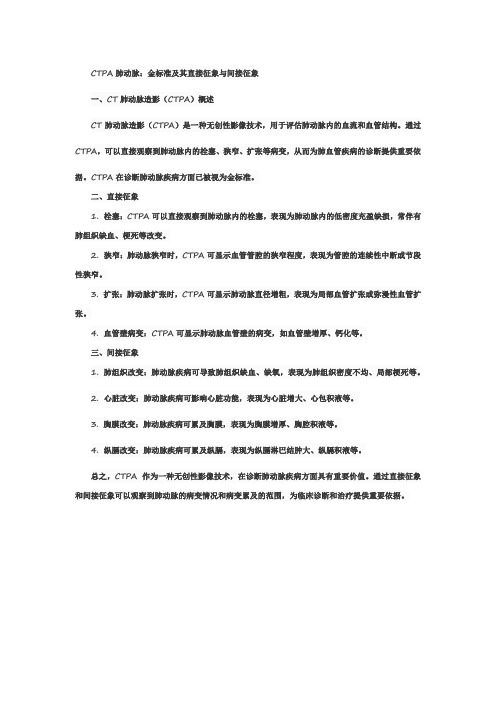
CTPA肺动脉:金标准及其直接征象与间接征象
一、CT肺动脉造影(CTPA)概述
CT肺动脉造影(CTPA)是一种无创性影像技术,用于评估肺动脉内的血流和血管结构。
通过CTPA,可以直接观察到肺动脉内的栓塞、狭窄、扩张等病变,从而为肺血管疾病的诊断提供重要依据。
CTPA在诊断肺动脉疾病方面已被视为金标准。
二、直接征象
1. 栓塞:CTPA可以直接观察到肺动脉内的栓塞,表现为肺动脉内的低密度充盈缺损,常伴有肺组织缺血、梗死等改变。
2. 狭窄:肺动脉狭窄时,CTPA可显示血管管腔的狭窄程度,表现为管腔的连续性中断或节段性狭窄。
3. 扩张:肺动脉扩张时,CTPA可显示肺动脉直径增粗,表现为局部血管扩张或弥漫性血管扩张。
4. 血管壁病变:CTPA可显示肺动脉血管壁的病变,如血管壁增厚、钙化等。
三、间接征象
1. 肺组织改变:肺动脉疾病可导致肺组织缺血、缺氧,表现为肺组织密度不均、局部梗死等。
2. 心脏改变:肺动脉疾病可影响心脏功能,表现为心脏增大、心包积液等。
3. 胸膜改变:肺动脉疾病可累及胸膜,表现为胸膜增厚、胸腔积液等。
4. 纵膈改变:肺动脉疾病可累及纵膈,表现为纵膈淋巴结肿大、纵膈积液等。
总之,CTPA作为一种无创性影像技术,在诊断肺动脉疾病方面具有重要价值。
通过直接征象和间接征象可以观察到肺动脉的病变情况和病变累及的范围,为临床诊断和治疗提供重要依据。
肺动脉CT血管造影技术(CTPA)

MIP
MIP在CTA中的应用广泛,它是通过计算机处理将扫描 获得的体素进行任意方向的数学线束透视投影,每一位线束 所遇到密度值高于所选阈值的像素或密度最高的像素被投影 在与线束垂直的平面上形成三维图像,可以从任意投影方向 进行观察,主要常用于显示具有相对较高密度的组织结构, 但所显示的结构与邻近结构没有深度关系。本组中MIP对 栓子的检出率仅次于MPR,尤其是对段及以下血管内栓子 的显示欠佳,是由于小血管的密度差变小所致。
肺动脉CT 血管造影技术
(CTPA)
崔丁也
肺动脉CT血管造影(CTPA)
因内源性或外源性栓子阻塞肺动脉或其主要分支引起肺循环障 碍的病理生理综合征。据国内外尸检报告,约有67%~79%PE 病人生前未能得到正确诊断。而国内的漏诊率高达80%以上; 未经治疗者,死亡率可高达20%-30%,及时诊治者,死亡率 可降至8%。目前,核素肺显像仍为PE常规检查,但是特异性 低,主要用于筛查病人。随着医学影像学设备的更新,CT和 MRI等微创检查方法,已逐步成为诊断PE的首选,CTPA诊断PE 的敏感性可达75%-100%,特异性可达80%-100%,对于叶 、段动脉显示的准确性更高,有助于明确肺动脉内栓子的位 置、范围、程度、性质和肺动脉血流动力学状态等。
No Image
No
No
Image Image
要点小结
肺循环的生理特点
肺循环的生理特点
肺动静脉循环时间非常短,约为2-4S,启动时间过早,肺 动脉远端分支对比剂充盈不佳,同时上腔静脉和右心房内 对比剂形成的硬射线伪影将干扰肺动脉大分支内栓子的显 示;过晚则肺静脉内对比剂充盈,影响段、亚段分支的显 示。
肺循环的生理特点
肺循环的途径: 右心室→肺动脉→肺部的毛细血管→肺静脉→左心房
肺动脉高压
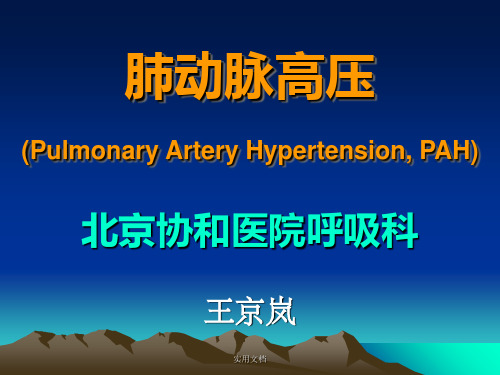
• PAH患者在确定使用血管扩张剂前都应作急性 血管反应试验,用以明确:
–是否存在肺血管收缩 –是否存在固定的肺血管结构改变 –判定预后以及评估应实用用文血档 管扩张剂的安全性
急性血管反应试验(2)
• 急性血管反应试验阳性判断标准
• ACCP/ESC:mPAP下降值≥10mmHg, mPAP绝对值下 降至≤40mmHg,伴CO增加或不变。
–多变量分析显示,严重的心包渗出示一项独立的危 险因素(P=0.006)
–两项多变量分析均显示实用,文档右室指数与预后相关
诊 断(13)
(五)病情严重程度的评估
• 4.血流动力学
–IPAH患者治疗前基线mRAP(>12mmHg)和 mPAP的升高,CO和SvO2的下降预示预后 不良。
–血管反应试验阳性而长期服用CCB者较阴 性者预后好。
肺动脉高压
(Pulmonary Artery Hypertension, PAH)
北京协和医院呼吸科
王京岚
实用文档
定义
• 肺动脉高压 (Pulmonary artery Hypertension, PAH)
肺血管阻力进行性增高,并导致右心室衰竭及死亡为 特征的一组疾病
• 肺循环高压 (Pulmonary Hypertension, PH)
约1/3的IPAH患者会出现阳性,但滴度多≤1:80
–HIV
• 2. 腹部超声
–排除肝硬化和/或门脉高压;鉴别门脉高压 缘于右心衰或肝硬实化用文档
诊 断(6)
(三)PAH的临床分类
• 3. 肺功能检查和动脉血气分析
–肺弥散量通常占预计值的40-80%,肺容量常 轻中度降低
肺动脉高压
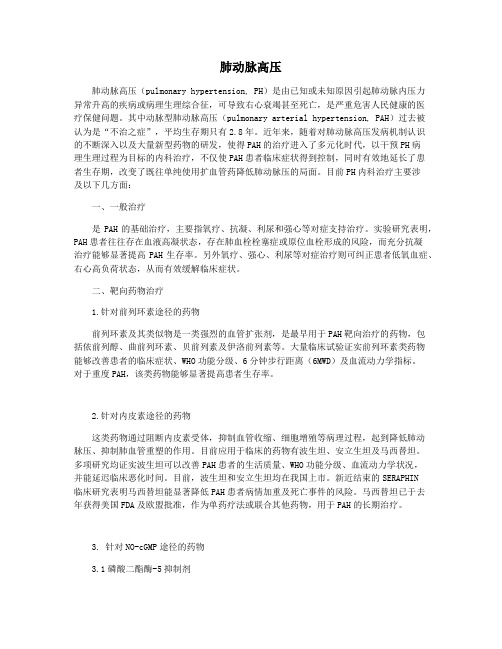
肺动脉高压肺动脉高压(pulmonary hypertension, PH)是由已知或未知原因引起肺动脉内压力异常升高的疾病或病理生理综合征,可导致右心衰竭甚至死亡,是严重危害人民健康的医疗保健问题。
其中动脉型肺动脉高压(pulmonary arterial hypertension, PAH)过去被认为是“不治之症”,平均生存期只有2.8年。
近年来,随着对肺动脉高压发病机制认识的不断深入以及大量新型药物的研发,使得PAH的治疗进入了多元化时代,以干预PH病理生理过程为目标的内科治疗,不仅使PAH患者临床症状得到控制,同时有效地延长了患者生存期,改变了既往单纯使用扩血管药降低肺动脉压的局面。
目前PH内科治疗主要涉及以下几方面:一、一般治疗是PAH的基础治疗,主要指氧疗、抗凝、利尿和强心等对症支持治疗。
实验研究表明,PAH患者往往存在血液高凝状态,存在肺血栓栓塞症或原位血栓形成的风险,而充分抗凝治疗能够显著提高PAH生存率。
另外氧疗、强心、利尿等对症治疗则可纠正患者低氧血症、右心高负荷状态,从而有效缓解临床症状。
二、靶向药物治疗1.针对前列环素途径的药物前列环素及其类似物是一类强烈的血管扩张剂,是最早用于PAH靶向治疗的药物,包括依前列醇、曲前列环素、贝前列素及伊洛前列素等。
大量临床试验证实前列环素类药物能够改善患者的临床症状、WHO功能分级、6分钟步行距离(6MWD)及血流动力学指标。
对于重度PAH,该类药物能够显著提高患者生存率。
2.针对内皮素途径的药物这类药物通过阻断内皮素受体,抑制血管收缩、细胞增殖等病理过程,起到降低肺动脉压、抑制肺血管重塑的作用。
目前应用于临床的药物有波生坦、安立生坦及马西替坦。
多项研究均证实波生坦可以改善PAH患者的生活质量、WHO功能分级、血流动力学状况,并能延迟临床恶化时间。
目前,波生坦和安立生坦均在我国上市。
新近结束的SERAPHIN临床研究表明马西替坦能显著降低PAH患者病情加重及死亡事件的风险。
2021版中国肺动脉高压诊断与治疗指南要点(附原文下载)

2021版中国肺动脉⾼压诊断与治疗指南要点(附原⽂下载)肺动脉⾼压(PH)是指由多种异源性疾病(病因)和不同发病机制所致肺⾎管结构或功能改变,引起肺⾎管阻⼒和肺动脉压⼒升⾼的临床和病理⽣理综合征,继⽽发展成右⼼衰竭甚⾄死亡。
《中国肺动脉⾼压诊断与治疗指南(2021版)》的发布,旨在进⼀步规范我国肺动脉⾼压的诊断与治疗。
关于PH的诊断流程以及动脉性肺动脉⾼压(PAH)的治疗策略,指南主要涉及以下内容。
PH的诊断流程PH的诊断建议从疑诊(临床及超声⼼动图筛查)、确诊(⾎流动⼒学诊断)、求因(病因诊断)及功能评价(严重程度评估)四个⽅⾯进⾏。
这四个⽅⾯并⾮严格按照流程分步进⾏,临床操作过程中可能会有交叉,其中病因诊断贯穿于PH诊断的全过程。
诊断策略及流程见图2。
1疑诊通过病史、症状、体征以及⼼电图、X线胸⽚等疑诊PH的患者,进⾏超声⼼动图的筛查,以明确发⽣PH的可能性。
要重视PH的早期诊断,对存在PAH相关疾病和/或危险因素,如家族史、结缔组织病(CTD)、先天性⼼脏病(CHD)、HIV感染、门脉⾼压或能诱发PAH的药物或毒物摄⼊史者,应注意定期进⾏PH的筛查。
2确诊对于存在PAH相关疾病和/或危险因素的患者,如果超声⼼动图⾼度怀疑PH,需要做RHC进⾏诊断与鉴别诊断。
3求因对于左⼼疾病或肺部疾病患者,当合并重度PH和/或右⼼室功能不全时,应转诊到PH中⼼,进⼀步寻找导致PH的病因。
如果核素肺通⽓/灌注(V/Q)显像显⽰呈肺段分布、与通⽓不匹配的灌注缺损,需要考虑慢性⾎栓栓塞性PH(CTEPH)。
根据CT肺动脉造影(CTPA)、右⼼导管检查(RHC)和肺动脉造影进⾏最终诊断。
4 功能评价对于明确诊断为PAH患者,需要根据WHO功能分级、6分钟步⾏试验(6 minutes walking test,6MWT)及相关检查结果等进⾏严重程度评估,以利于制定治疗⽅案。
【推荐意见】推荐超声⼼动图作为疑诊PH患者⾸选的⽆创性检查(1C)。
- 1、下载文档前请自行甄别文档内容的完整性,平台不提供额外的编辑、内容补充、找答案等附加服务。
- 2、"仅部分预览"的文档,不可在线预览部分如存在完整性等问题,可反馈申请退款(可完整预览的文档不适用该条件!)。
- 3、如文档侵犯您的权益,请联系客服反馈,我们会尽快为您处理(人工客服工作时间:9:00-18:30)。
血液系统疾病(骨髓增生性疾病,脾脏切除术 )、系统性疾病(结节病,肺朗格汉斯细胞组 织细胞增生症,淋巴管肌瘤病,多发性神经纤 维瘤,血管炎)、代谢性疾病(糖原贮积病, 高雪氏病,甲状腺疾病)、其他(肿瘤阻塞, 纤维性纵隔炎,透析治疗的慢性肾衰竭)
Pulmonary arterial hypertension is restricted to those with a
PART 04
Diagnosis and Assessment of Pulmonary Hypertension
In patients with suspected PH, the diagnostic approach includes four stages: Suspicion Detection Classification Functional evaluation
than 1:1 at the midventricular level on axial images) 4. Decreased right ventricular ejection fraction 5. Dilatation of the inferior vena cava and hepatic veins 6. Pericardial effusion
Cardiac MR Imaging
• Morphologic cardiac findings
1. Right ventricular dilatation and hypertrophy 2. Flattening of the interventricular septum or leftward bowing 3. Right ventricular morphologic changes ranging from a normal
Long-standing Leftto-Right Shunt
Pulmonary Capillary Hemangiomatosis and Veno-occlusive Disease
Pulmonary Veno-occlusive Disease
Chronic Thromboembolic Disease
ANA,ENA,ANCA,RF,RA相关抗体
PAH评估 筛查风湿免疫病
D-Dimmer;抗磷脂抗体、抗心磷脂抗体、 筛查肺栓塞 狼疮抗凝物
血气分析
了解血氧水平
甲状腺功能
了解有无甲亢
乙肝标记物、HIV抗体
了解有无乙肝与AIDS
基因检查
遗传性肺动脉高压
治疗:
• 氧疗 • 抗凝治疗 • 钙通道阻滞剂 • 靶向药物治疗 • 介入治疗和手术治疗
Pulmonary hypertension resulting from heart disease (group 2) implies an increase in pulmonary arterial pressure due to backward transmission of pressure elevation (postcapillary pulmonary hypertension) and is defined as a mean pulmonary arterial pressure of 20 mmHg or more and a pulmonary wedge pressure greater than 15 mmHg.
Pulmonary Hypertension:
How the Radiologist can help
杜倩妮 2019.08
目录
CONTENTS
01. Definition 02. Classification 03. Pathophysiology and
Clinical Course
04.
Diagnosis and Assessment of Pulmonary Hypertension
1. The main pulmonary artery with a diameter of 29 mm or more (positive predictive value of 97%, sensitivity of 87%, and specificity of 89%)
2. A segmental artery–to-bronchus diameter ratio of 1:1 or more in three or four lobes (specificity of 100%)
第4届世界PH研讨会对PH的分类
①动脉性肺动脉高压
特发性/遗传性/药物和毒物诱导/与疾病相关 性(结缔组织疾病、HIV感染、门脉高压、先 天性心脏病、血吸虫病和慢性溶血性贫血)、 新生儿持续性肺动脉高压、肺静脉闭塞病、肺 毛细血管瘤样增生症
②与左心疾病相关的肺高压
③与肺疾病和/或低氧相关的肺高压 ④慢性血栓栓塞性肺高压(CTEPH) ⑤多种机制和/或不明机制引起的肺 高压
1. central pulmonary arterial dilatation;
2. pruning of the peripheral arteries;
3. increased diameter (15 mm in women and 16 mm in men) of the right interlobar artery;
crescent shape to a more concentric form 4. Right atrial enlargement 5. Tricuspid regurgitation
Cardiac MR Imaging
• Cine Imaging
Assess left and right ventricular volume, mass and function Assess wall motion abnormalities
4. reduced retrosternal air space on lateral views, a result of right ventricular dilatation.
Multidetector CTPA(vascular, cardiac, and parenchymal)
• Vascular Signs
PART 01 Definition
肺高压(Pulmonary hypertension,PH) :是一组由异源性疾病和不
同发病机制引起的以肺血管阻力持续增高为特征的临床病理生理综合征。
右心导管术是金标准(有创),海平面状态下、静息时,肺动脉平均压 ≥25mmHg。
PART 02 Classification
Multidetector CTPA(vascular, cardiac, and parenchymal)
• Parenchymal Signs
Centrilobular ground-glass nodules are a feature of pulmonary hypertension and are especially common in patients with idiopathic pulmonary arterial hypertension. Also can be seen in patients with pulmonary capillary hemangiomatosis.
3. The main pulmonary arterial diameter larger than that of the ascending aorta(positive predictive value of 96% and specificity of 92%, especially in patients younger than 50 years old)
Diagram shows the imaging work-up of patients with PH
Diagram shows the iments with suspected PH
Chest Radiography
Chest radiography is usually the initial imaging study performed. The classic radiographic findings of pulmonary hypertension are evident only late in the disease process. Such late findings include:
谢谢聆听
Multidetector CTPA(vascular, cardiac, and parenchymal)
• Cardiac Signs
1. Right ventricular hypertrophy(wall thickness of more than 4 mm) 2. Straightening or leftward bowing of the interventricular septum 3. Right ventricular dilatation (right ventricle–to–left ventricle diameter ratio of more
